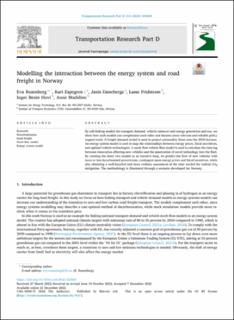| dc.contributor.author | Rosenberg, Eva | |
| dc.contributor.author | Espegren, Kari | |
| dc.contributor.author | Danebergs, Janis | |
| dc.contributor.author | Fridstrøm, Lasse | |
| dc.contributor.author | Hovi, Inger Beate | |
| dc.contributor.author | Madslien, Anne | |
| dc.coverage.spatial | Norway, Oslo | en_US |
| dc.date.accessioned | 2023-06-14T12:15:02Z | |
| dc.date.available | 2023-06-14T12:15:02Z | |
| dc.date.created | 2022-12-23T14:42:53Z | |
| dc.date.issued | 2022-12-21 | |
| dc.identifier.citation | Transportation Research Part D: Transport and Environment. 2022, 114 1-19. | en_US |
| dc.identifier.issn | 1361-9209 | |
| dc.identifier.uri | https://hdl.handle.net/11250/3071347 | |
| dc.description | Published by Elsevier Ltd. This is an open access article under the CC BY license
(http://creativecommons.org/licenses/by/4.0/). | en_US |
| dc.description.abstract | By soft-linking models for transport demand, vehicle turnover and energy generation and use, we show how such models can complement each other and become more relevant and reliable policy support tools. A freight demand model is used to project commodity flows onto the 2050 horizon. An energy system model is used to map the relationships between energy prices, fiscal incentives, and optimal vehicle technologies. A stock-flow vehicle fleet model is used to calculate the time lag between innovation affecting new vehicles and the penetration of novel technology into the fleet. By running the latter two models in an iterative loop, we predict the flow of new vehicles with more or less decarbonized powertrains, contingent upon energy prices and fiscal incentives, while also obtaining a well-founded and more realistic assessment of the time needed for radical CO2 mitigation. The methodology is illustrated through a scenario developed for Norway. | en_US |
| dc.description.abstract | Modelling the interaction between the energy system and road freight in Norway | en_US |
| dc.language.iso | eng | en_US |
| dc.publisher | Elsevier Ltd | en_US |
| dc.rights | Navngivelse 4.0 Internasjonal | * |
| dc.rights.uri | http://creativecommons.org/licenses/by/4.0/deed.no | * |
| dc.subject | Decarbonization | en_US |
| dc.subject | Road freight | en_US |
| dc.subject | Stock-flow model | en_US |
| dc.subject | Energy system model | en_US |
| dc.title | Modelling the interaction between the energy system and road freight in Norway | en_US |
| dc.title.alternative | Modelling the interaction between the energy system and road freight in Norway | en_US |
| dc.type | Journal article | en_US |
| dc.type | Peer reviewed | en_US |
| dc.rights.holder | © 2022 The Author(s). | en_US |
| dc.source.articlenumber | 103569 | en_US |
| dc.description.version | publishedVersion | en_US |
| cristin.ispublished | true | |
| cristin.fulltext | original | |
| cristin.qualitycode | 2 | |
| dc.identifier.doi | 10.1016/j.trd.2022.103569 | |
| dc.identifier.cristin | 2097253 | |
| dc.source.journal | Transportation Research Part D: Transport and Environment | en_US |
| dc.source.volume | 114 | en_US |
| dc.source.issue | Januar 2023 | en_US |
| dc.source.pagenumber | 1-19 | en_US |
| dc.relation.project | Norges forskningsråd: 280989 | en_US |
| dc.relation.project | Norges forskningsråd: 296205 | en_US |

